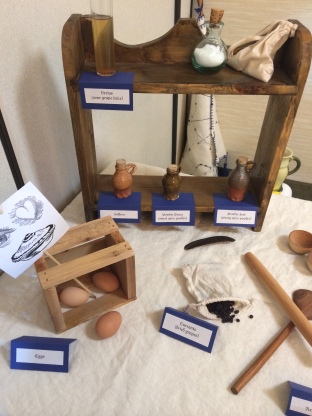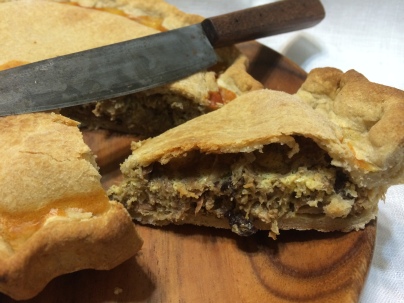At long last, here is a complete description of how I made Crustardes of Flessh for KASC back in March, including recipes and quantities. Enjoy!

Continue reading “How to Make Crustardes of Flessh (finally!)”
At long last, here is a complete description of how I made Crustardes of Flessh for KASC back in March, including recipes and quantities. Enjoy!

Continue reading “How to Make Crustardes of Flessh (finally!)”
During the process of creating my pie for KASC, I had to not only do a lot of test cooking, but I also had to do a ton of close reading. Reading a medieval recipe is a complex and nuanced endeavor. Here is an example of my process of interpreting a recipe.
Continue reading “Medieval Cooking is Complex: A Complete Recipe Annotation”
Photos of my displays / entries from An Tir’s 2015 Kingdom Arts and Sciences Championship:















If you missed seeing me present my pie entry on Sunday, now you can play along at home thanks to the video by Russ Gilman-Hunt:
During the Q&A portion I explained more about some of my recreation choices (such as how I chose the spices I used), about pie crusts generally, and where I hope to take this project in the future. Watching this now, I see soooooo much detail I could have added. I felt so constrained by the time limit, which was frustrating. I do wish I had talked more about my process; I think I didn’t give myself enough credit for how much work went into mastering making this one particular pie. But overall I felt incredibly good about my presentation, and I even (shockingly!) don’t hate watching this on film.
And if you want to hear everything I have to say on the subjects of medieval pie, 14th century English cooking, the intersection of food and social class, and how to choose ingredients that are as authentic as possible, clearly the only answer is to take a class from me at an event 🙂

Here are the abstracts from each of these, to get you a little excited:
Early 16th century French miniature: For this entry I aimed to replicate one of the full-page miniatures found in an illuminated manuscript originally commissioned for a Dominican cloister in Poissy, France around 1510. This work was based in large part on my close study of the manuscript itself and my analysis of the painting techniques used within it. I supplemented this with research into similar manuscripts from the same time period and place, especially ones which are incomplete (which give clues to the techniques used to produce their illuminations). My main interest in completing this project was to practice using more historical materials and techniques in my scribal work. I made my own ink and paints and documented the processes I used for each. The finished painting was completed on parchment using paints I made from period pigments or modern chemically similar substitutes.
Late 14th century pie: For this entry I prepared a meat pie based on a recipe from Forme of Cury, a culinary manuscript attributed to Richard II’s master cooks and believed to have been compiled around 1390. The pie I chose to recreate is representative of trends in foods consumed by high-status individuals in England during the high medieval and late medieval periods. Building on research I did for a pie crust project presented last year, the crust was prepared using stone ground and sieved flour from heirloom rivet and bread wheat grown in mixed fields in England. The filling contains three different types of birds: squab, chicken, and quail (as a stand-in for passerine songbirds, which are largely illegal to kill in the US), as well as eggs, currants, and spices. The consumption of birds was a sign of wealth during this time period, so it is fitting that a royal pie contain multiple types of desirable (and expensive) birds. The other filling ingredients would have been imported to England, adding considerably to their cost. This is also a very labor intensive food; multiple steps and some specialized techniques are required to produce this pie, which is a further indication of the social context in which this pie would have existed.
Women’s Work: Through an examination of archived medieval documents, this paper presents evidence for women in guilds and trades in York during the reigns of Edward I through III. I examined digital transcriptions of primary source documents, including the York Register of Freemen and the Ebor Cause Papers, extracting data about female names and occupations. By analyzing these data, I was able to compare my findings to those of other researchers who have written about women as workers in other areas of medieval Europe. Overall, I found that the situation for women in York was consistent with that for women in other medieval European cities: while women did participate (sometimes significantly) in wage-work, women’s participation was typically limited to certain types of jobs in certain industries, and women rarely achieved full guild membership.
Again, to read the full papers, hop over to files.